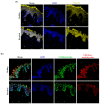The Expression of Cytokines and Chemokines Potentially Distinguishes Mild and Severe Psoriatic Non-Lesional and Resolved Skin from Healthy Skin and Indicates Different Stages of Inflammation
- PMID: 39457071
- PMCID: PMC11509107
- DOI: 10.3390/ijms252011292
The Expression of Cytokines and Chemokines Potentially Distinguishes Mild and Severe Psoriatic Non-Lesional and Resolved Skin from Healthy Skin and Indicates Different Stages of Inflammation
Abstract
In the psoriatic non-lesional (PS-NL) skin, the tissue environment potentially influences the development and recurrence of lesions. Therefore, we aimed to investigate mechanisms involved in regulating tissue organization in PS-NL skin. Cytokine, chemokine, protease, and protease inhibitor levels were compared between PS-NL skin of patients with mild and severe symptoms and healthy skin. By comparing mild and severe PS-NL vs. healthy skin, differentially expressed cytokines and chemokines suggested alterations in hemostasis-related processes, while protease inhibitors showed no psoriasis severity-related changes. Comparing severe and mild PS-NL skin revealed disease severity-related changes in the expression of proteases, cytokines, and chemokines primarily involving methyl-CpG binding protein 2 (MECP2) and extracellular matrix organization-related mechanisms. Cytokine and chemokine expression in clinically resolved versus healthy skin showed slight interleukin activity, differing from patterns in mild and severe PS-NL skin. Immunofluorescence analysis revealed the severity-dependent nuclear expression pattern of MECP2 and decreased expression of 5-methylcytosine and 5-hydroxymethylcytosine in the PS-NL vs. healthy skin, and in resolved vs. healthy skin. Our results suggest distinct cytokine-chemokine signaling between the resolved and PS-NL skin of untreated patients with varying severities. These results highlight an altered inflammatory response, epigenetic regulation, and tissue organization in different types of PS-NL skin with possibly distinct, severity-dependent para-inflammatory states.
Keywords: chemokines; cytokines; non-lesional skin; psoriasis; psoriasis severity; resolved skin.
Conflict of interest statement
The authors declare no competing interests.
Figures








Similar articles
-
A single intradermal injection of IFN-γ induces an inflammatory state in both non-lesional psoriatic and healthy skin.J Invest Dermatol. 2012 Apr;132(4):1177-87. doi: 10.1038/jid.2011.458. Epub 2012 Jan 26. J Invest Dermatol. 2012. PMID: 22277938 Free PMC article.
-
Interleukin-29 induces epithelial production of CXCR3A ligands and T-cell infiltration.J Mol Med (Berl). 2016 Apr;94(4):391-400. doi: 10.1007/s00109-015-1367-y. Epub 2015 Nov 26. J Mol Med (Berl). 2016. PMID: 26612594
-
LC-MS/MS analysis of lesional and normally looking psoriatic skin reveals significant changes in protein metabolism and RNA processing.PLoS One. 2021 May 26;16(5):e0240956. doi: 10.1371/journal.pone.0240956. eCollection 2021. PLoS One. 2021. PMID: 34038424 Free PMC article.
-
Psoriasis is a disease of the entire skin: non-lesional skin displays a prepsoriasis phenotype.Eur J Dermatol. 2021 Apr 1;31(2):143-154. doi: 10.1684/ejd.2021.4015. Eur J Dermatol. 2021. PMID: 34001466 Review.
-
The cytokine and chemokine network in psoriasis.Clin Dermatol. 2007 Nov-Dec;25(6):568-73. doi: 10.1016/j.clindermatol.2007.08.011. Clin Dermatol. 2007. PMID: 18021894 Review.
Cited by
-
Association of +67 G/A and -426 T/C Polymorphism in Eotaxin (CCL11) Gene with Psoriasis Phenotypes.Genes (Basel). 2025 Feb 27;16(3):288. doi: 10.3390/genes16030288. Genes (Basel). 2025. PMID: 40149440 Free PMC article.
-
Exploring the Molecular Mechanisms of Psoriasis and Other Skin Disorders: Unveiling New Insights.Int J Mol Sci. 2025 Apr 25;26(9):4061. doi: 10.3390/ijms26094061. Int J Mol Sci. 2025. PMID: 40362301 Free PMC article.
References
-
- Ghaffarinia A., Ayaydin F., Póliska S., Manczinger M., Bolla B.S., Flink L.B., Balogh F., Veréb Z., Bozó R., Szabó K., et al. Psoriatic Resolved Skin Epidermal Keratinocytes Retain Disease-Residual Transcriptomic and Epigenomic Profiles. Int. J. Mol. Sci. 2023;24:4556. doi: 10.3390/ijms24054556. - DOI - PMC - PubMed
MeSH terms
Substances
Grants and funding
- 739593/EU's Horizon 2020 research and innovation program
- PD138837/Hungarian National Research, Development and Innovation Office
- K135084/Hungarian National Research, Development and Innovation Office
- n/a/János Bolyai Research Scholarship
- ÚNKP-23-5-SZTE-686/New National Excellence Program of the Ministry for Culture and Innovation, National Research, Development and Innovation Fund
- ÚNKP-23-4-SZTE-337/New National Excellence Program of the Ministry for Culture and Innovation, National Research, Development and Innovation Fund
- ÚNKP-23-5/New National Excellence Program of the Ministry for Culture and Innovation, National Research, Development and Innovation Fund
- FEIF/646-4/2021-ITM_SZERZ/Szeged Scientists Academy under the sponsorship of the Hungarian Ministry of Innovation and Technology
- TKP2021-EGA-28/Ministry of Culture and Innovation of Hungary from the National Research, Development and Innovation Fund
- n/a/HUN-REN Hungarian Research Network
LinkOut - more resources
Full Text Sources
Medical

